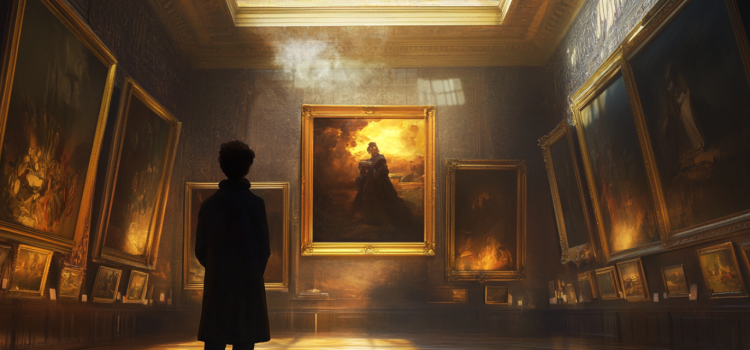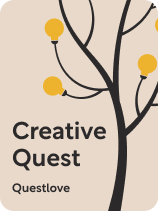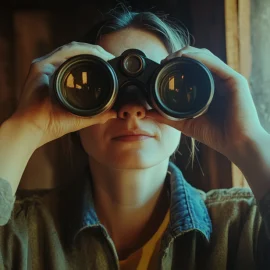

This article is an excerpt from the Shortform book guide to "Creative Quest" by Questlove. Shortform has the world's best summaries and analyses of books you should be reading.
Like this article? Sign up for a free trial here.
Do you want to know how to find creative inspiration? How can you grow as a creator?
Finding creative inspiration can be difficult, especially when you’re in a creative slump. In his book Creative Quest, Questlove provides four ways to bolster your creative inspiration.
Continue reading to learn more about each one.
1. Interact With Other Creative Works
Questlove’s first tip for how to find creative inspiration is to interact with other works. He writes that exploring and experiencing other creative works can inspire you with ideas and help jumpstart your creative process. He suggests three exercises:
1. Get organized. Simple organizing tasks like sorting art supplies or arranging recipe cards can be good warm-up exercises that put you in the right headspace to pursue creative work. Questlove writes that organizing slows your heart rate and puts you in a contemplative state that’s conducive to creativity. Also, when organizing, you may notice details or patterns in the artwork you wouldn’t ordinarily notice. For example, when going through a binder of art references, you might notice how artists use lighting in different ways, inspiring you for your next drawing.
(Shortform note: Questlove’s advice mainly deals with organizing creative inspirations, but psychologists explain that organizing your space, in general, can also trigger psychological benefits conducive to creativity. They explain that cluttered spaces drain your energy and make it harder for you to focus because your brain’s visual cortex becomes overstimulated. When you organize your space, your brain experiences a sense of safety and predictability that helps you calm your mind and free up cognitive resources you can then redirect toward your creative work. However, as you take advantage of the benefits of organization, make sure organizing doesn’t become an avoidance strategy to postpone starting your creative work.)
2. Look at creative works in fresh ways. Try interacting with songs, books, movies, and other creative works in unconventional ways—like reading or listening to them backward or turning them upside down—to see them in a new light. For example, you could view photos in black and white or listen to a song at half speed. When you change how you look at something, your brain processes information differently and can come up with fresh ideas.
(Shortform note: When you look at familiar things in unusual ways, you’re practicing what literary theorists call defamiliarization. Victor Shklovsky, who introduced this concept in 1917, believed that when objects become too familiar, we stop truly seeing them—like the way you drive home on autopilot and barely notice the journey. By deliberately making the familiar strange, you force your brain out of this automatic perception, allowing you to experience ordinary things with renewed attention and freshness.)
3. Copy works you admire. When you’re struggling to come up with ideas, try recreating artwork that inspires you. For instance, if you’re an artist, you could practice drawing comic panels in the style of a graphic novelist you admire. Copying other works helps in two ways: First, it keeps you actively creating even when you don’t have original ideas. Second, it teaches you new skills because you must study the original creator’s methods, materials, and artistic choices, which builds a foundation that will help you flesh out your own style.(Shortform note: In Decoding Greatness, Ron Friedman calls the process of copying the works of others reverse engineering. He argues that analyzing and reproducing existing work builds your mental library of creative “recipes” and techniques you can later use in your own work. Friedman suggests several approaches beyond simple copying, including combining unrelated ideas (for example, the way Star Trek merged westerns with sci-fi) and elevating background elements into the spotlight (the way Rosencrantz and Guildenstern Are Dead centered on minor characters from Hamlet).)
2. Step Outside Your Comfort Zone
Another method Questlove recommends to stretch your creativity is to try new things. He argues that creative people can get stuck doing what they know best—using the same techniques, working with familiar materials, or creating in predictable styles. When you push yourself beyond your comfort zone, you can discover ideas you might otherwise never try.
For example, in 1991, MTV’s show Unplugged invited hip-hop artists to perform their songs without electronic equipment. Questlove writes that when LL Cool J performed his songs like “Mama Said Knock You Out” with a live band instead of pre-recorded samples and electronic beats, he created entirely new versions that sounded more like folk music. By stripping away typical hip-hop elements, artists gave their songs new life and energy.
Questlove suggests several ways to challenge yourself similarly:
1. Spend time with different types of creators. When you see how creators in other fields create their work, you can learn new ways to approach yours. For example, if you’re a painter, you could spend time watching animators work. By observing their workflow, you might discover new ideas about color, rhythm, or composition.
2. Experience art that challenges or confuses you. When art feels strange or hard to understand, your brain works harder to make sense of it. This mental stretch can help you think in new ways. For example, if you usually listen to rock music, try listening to classical music.
3. Learn a new skill. Questlove suggests you spend a small part of your creative time learning something different from your usual work. For example, a dancer who takes up creative writing might discover new ways to think about rhythm and storytelling that enhance their choreography. You don’t need to become an expert at the new skill—just learn enough to gain new perspectives you can bring back to your main creative work.
3. Work With Other Creatives
Questlove encourages you to not only spend time with other creators but to work directly with them. He recommends working alongside other creative people in two ways: finding mentors who can teach you basic skills and partnering with other artists on joint projects.
Learn From Mentors
Questlove says that when you’re early in your artistic career, you should find a mentor to teach you basic skills and guide your creative development. He writes that the most important part of working with a mentor isn’t getting their advice—it’s how you use it. Focus on being a good student by listening, absorbing information, and using their feedback to improve your creative abilities.
Questlove notes that not everyone will have a formal flesh-and-blood mentor, and that’s OK. You can still learn by studying successful people in your field. For example, you can learn painting techniques by studying famous artists’ work in museums or improve your writing by reading and analyzing your favorite authors’ books.
Collaborate With Other Artists
Questlove writes that collaborating with other artists can push everyone’s creativity to the next level. He explains that most creative breakthroughs don’t come from inventing new things, but rather from combining existing ideas in fresh ways. When you collaborate with others, you combine your ideas and skills to make unique work neither of you could create alone.
To maximize the creative power of collaboration, don’t limit yourself to working with people similar to you. Try working with people from other genres or backgrounds. Their different perspectives help you learn more about your creative approach and also discover fresh ideas in your field.
Questlove adds that it’s natural to feel competitive when working with other artists. In fact, it’s a good thing—competition can inspire you to work harder and create better art. For example, Questlove recalls a studio session where he and a few other artists took turns playing their unfinished songs for each other. When his track “Double Trouble” received a lukewarm response compared to the others, he used that feedback as motivation, returned to the studio that night, and completely reworked it.
Questlove wasn’t competing for money or fame—he simply wanted to create something that would impress his fellow artists. This kind of healthy competition pushes artists to improve their craft. You can find similarly healthy ways to compete: Join local artist meetups where people share their unfinished work and give feedback. You can even challenge yourself by trying to match or surpass the quality of past artists’ work.
4. Be Selective About Artistic Influences
Although it’s important to know where to find ideas to influence your work, Questlove suggests you draw inspiration from only a few select sources. He explains that having too many ideas and influences can make your work less original and impactful. Unlike artists from the past who had limited sources of inspiration, we can access millions of songs, books, videos, and artwork with a few clicks. This easy access creates a problem—when we can quickly find any answer or idea we want, we don’t spend time thinking deeply about our work or coming up with original ideas.
Questlove offers two tips to cut down on the noise and be selective about creative influences:
1. Sort your ideas. Keep what you need right now, store good ideas that don’t quite fit for this project for later, and discard what doesn’t fit. When choosing influences, trust your gut feeling. You don’t need to fully understand why a piece of music or art moves you—what matters is that it sparks ideas. For example, you can create a painting inspired by the visual appearance of a mechanical device, even if you don’t understand the device’s function.
2. Identify everything you don’t want to be as a creator. Questlove argues that it’s easier to define what you’re not than it is to try to define what you are. For example, it’s often easier to say “I don’t want my music to sound like heavy metal” than to explain exactly what sound you want. By ruling out what doesn’t fit, you can focus on developing work that truly feels like you. This helps you branch out from others and create something genuine and original.

———End of Preview———
Like what you just read? Read the rest of the world's best book summary and analysis of Questlove's "Creative Quest" at Shortform.
Here's what you'll find in our full Creative Quest summary:
- How creative geniuses come up with their groundbreaking ideas
- Tips and strategies that anybody can use to access their creativity
- Why you should work directly with other creatives






